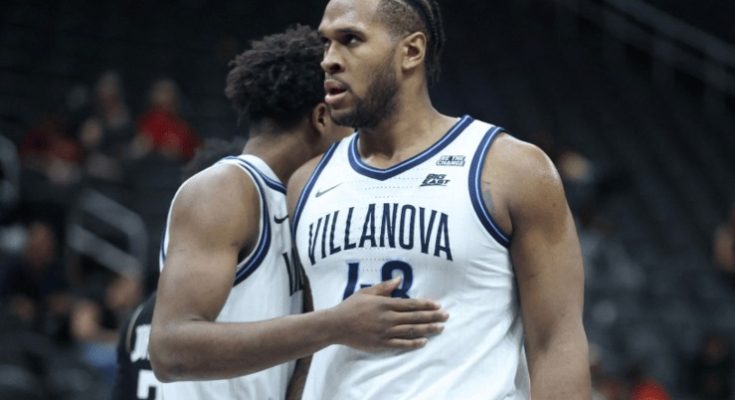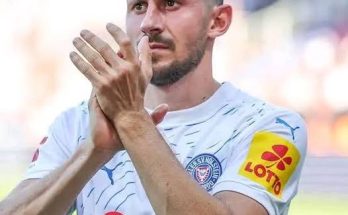The whispers from Los Angeles have grown louder, evolving from faint murmurs of excitement about a promising undrafted talent to a stark reminder of the harsh realities of professional sports. Eric Dixon, the former Villanova standout, seemed destined for the bright lights of the NBA, reportedly on the cusp of signing a two-way deal with the Lakers after the 2025 NBA Draft. His collegiate career, particularly his final season where he led the nation in scoring with an impressive 23.3 points per game, showcased a versatile big man with a developing perimeter game, shooting over 40% from three-point range. Such numbers, especially for a big, are tantalizing in the modern NBA, where spacing and shooting are paramount. He was exactly the kind of diamond-in-the-rough discovery that shrewd front offices covet, a player who, despite falling through the cracks of the draft, possessed tangible skills that could translate to the next level. The anticipation among Lakers fans was palpable; the idea of an unheralded but highly productive collegiate player potentially blossoming into a valuable contributor was a narrative that resonated deeply. Summer League was supposed to be his proving ground, an opportunity for him to showcase his skills against other aspiring NBA hopefuls and solidify his place on the Lakers’ developmental roster. Instead, a more sobering reality has emerged, one that casts a long shadow over his immediate future and offers a crucial, albeit unfortunate, lesson on the precarious nature of careers in professional basketball.
The news, as reported by Dan Woike of The Athletic, sent a ripple of concern through the Lakers faithful. Dixon, surprisingly absent from the Las Vegas Summer League, was spotted in a walking boot, utilizing a scooter to get around. This wasn’t the image anyone had in mind for a player on the verge of a professional breakthrough. The revelation that he had yet to officially sign his two-way deal, and that the Lakers were actively getting opinions on the best course of action regarding his foot injury, served as a stark, deflating reality check. It’s a situation that underscores the razor-thin margins and the inherent fragility of opportunity in the NBA, particularly for undrafted players fighting for their chance. For these athletes, every moment, every practice, every minute on the court is a high-stakes audition. An injury, especially before the ink on a contract has even dried, can be a devastating setback, potentially derailing years of dedication and sacrifice.
To truly grasp the gravity of Dixon’s situation, it’s essential to understand the intricate landscape of undrafted free agency and two-way contracts in the NBA. The NBA Draft, while a pinnacle for many young basketball players, only accounts for 58 or 60 selections across two rounds, depending on any forfeited picks. This leaves a vast pool of talented collegiate and international players who, despite possessing NBA-level skills and potential, go unselected. These players become “undrafted free agents” (UDFAs), and their path to the NBA is significantly more challenging, yet it’s a path that has been successfully navigated by numerous impactful players throughout league history. Think of players like Fred VanVleet, a quintessential example of an undrafted player who not only made it but thrived, becoming an NBA champion and an All-Star. Their journey is a testament to perseverance, skill, and often, a bit of luck in landing with the right organization.
For UDFAs, the immediate post-draft period is a whirlwind of phone calls, agent discussions, and frantic negotiations. Teams, having exhausted their draft picks, scramble to secure the rights to the most promising undrafted talents, often offering Summer League invites, Exhibit 10 contracts, or, in more substantial cases, two-way deals. A two-way contract is a relatively recent innovation in the NBA’s collective bargaining agreement, designed to bridge the gap between the G-League and the main NBA roster. It allows teams to carry three additional players beyond their standard 15-man roster. These two-way players can spend up to 50 days with their NBA team during the regular season, while also gaining valuable playing time and development in the G-League. Crucially, they earn a prorated portion of the NBA rookie minimum salary while with the NBA team and a G-League salary when with the affiliate. For many UDFAs, a two-way deal is the golden ticket, offering a legitimate pathway to prove themselves, hone their skills, and eventually, earn a standard NBA contract. It’s a win-win: the player gets a chance, and the team gets a low-risk, high-reward developmental asset.
The reported agreement between Dixon and the Lakers for a two-way deal was, therefore, a significant step. It indicated that the Lakers, a franchise known for its meticulous scouting and player development, saw something in Dixon that transcended his undrafted status. His unique blend of scoring prowess, post-game, and burgeoning three-point shooting likely made him an attractive prospect for a team always looking to optimize its roster around its star players. The fact that the agreement was reported by multiple credible sources, including the ubiquitous Shams Charania, underscored the perceived certainty of the deal. However, as Dan Woike’s subsequent report illuminated, “agreed to” is not the same as “signed.” This distinction is critical and highlights a frequently overlooked aspect of these early-offseason arrangements. Until the pen touches paper, and the contract is officially submitted to the league, nothing is truly guaranteed.
This brings us to the most poignant aspect of Dixon’s current predicament: the foot injury. Injuries are an unfortunate, yet undeniable, part of professional sports. For established veterans on guaranteed contracts, an injury can mean time off, rehabilitation, and a return to the court, with their salary and roster spot largely secure. For a rookie, especially an undrafted one, an injury before officially signing can be catastrophic. The financial implications are stark. Players on guaranteed contracts are paid regardless of injury. Those on non-guaranteed deals, or those with agreements that haven’t been finalized, are in a far more vulnerable position. Teams are operating businesses, and while they invest in player development, they are also constantly evaluating risk. A significant injury to an unproven player before the contract is fully guaranteed represents a substantial risk. The team has to weigh the cost of rehabilitation, the uncertainty of recovery, and the opportunity cost of dedicating a valuable two-way slot to a player who may not be able to contribute immediately.
In Dixon’s case, the Lakers’ cautious approach, as described by Woike, is entirely understandable from a team management perspective. They are “getting opinions on what the best move is.” This translates to consulting with medical specialists, assessing the severity of the injury, understanding the recovery timeline, and evaluating the long-term prognosis. Is it a minor tweak that will resolve quickly, allowing him to be ready for training camp? Or is it something more serious, potentially requiring extended rehabilitation and impacting his ability to play for a significant portion of his rookie season? Foot injuries, in particular, can be especially concerning for big men, given the constant pounding and stress placed on their lower extremities. A chronic foot issue could severely limit his mobility and effectiveness in a league that demands explosive athleticism.
The decision facing the Lakers is complex. If they sign Dixon to the two-way deal, they are committing a roster spot and a portion of their financial resources to a player whose immediate availability and long-term health are now in question. While two-way contracts are relatively inexpensive compared to standard NBA deals (around $580,000 for the 2024-25 season, half the rookie minimum), every dollar and every roster spot matters, especially for a team like the Lakers that often operates close to the luxury tax and hard cap thresholds. They have other undrafted prospects to consider, and two-way spots are valuable commodities. The league’s new collective bargaining agreement allows teams to carry three two-way players, but even with that increased flexibility, each spot is meticulously allocated. Currently, the Lakers reportedly have Christian Koloko and Trey Jemison on two-way deals, leaving one open spot. This open spot is precisely what Dixon was expected to fill.
If the Lakers decide to withdraw the offer or delay signing him, Dixon faces an even tougher uphill battle. He would re-enter the pool of unsigned UDFAs, likely needing to fully recover from his injury before any other team would seriously consider giving him an opportunity. This could mean a significant delay in his professional career, potentially spending a year focusing solely on rehabilitation, perhaps even playing in the G-League without the security of a two-way contract, hoping to earn an opportunity down the line. It’s a testament to the brutal, competitive nature of the NBA, where every setback, no matter how unforeseen, can have profound implications.
Beyond the immediate financial and roster implications for both player and team, this situation offers a valuable lesson in the broader ecosystem of professional basketball. For aspiring athletes, it’s a stark reminder that talent alone is often not enough. Health, timing, and a bit of luck play equally significant roles. The meticulous care that professional organizations take in evaluating potential new players, even those seemingly on the fringes, underscores the immense investments of time, money, and resources involved. Every signing, from a max contract superstar to a two-way rookie, is a calculated risk.
Furthermore, it highlights the often-unseen work of front office personnel, scouts, and medical staff. Their job isn’t just to identify talent, but to conduct thorough due diligence, assessing not only a player’s on-court abilities but also their physical durability, character, and overall fit within the organization’s culture. In a high-stakes environment like the NBA, where winning is paramount and millions of dollars are on the line, every piece of information is critical, and every decision is scrutinized.
The transparency provided by reporters like Dan Woike is also crucial in these scenarios. In a world saturated with rumors and speculation, credible journalists who can get to the heart of a story, confirming details and providing context, are invaluable. Woike’s report cut through the initial excitement, offering a more nuanced and realistic picture of Dixon’s situation, thereby educating fans on the complexities behind the scenes.
Looking ahead, what are the potential outcomes for Eric Dixon? The best-case scenario, from his perspective, is that the foot injury is minor, and the Lakers, after receiving positive medical opinions, still proceed with the two-way contract. He would then have a full opportunity to participate in training camp, learn the Lakers’ system, and prove his worth. Even if he starts in the G-League, he would be on a defined path with the NBA team maintaining his rights and having the ability to call him up.
A less favorable, but still plausible, outcome is that the Lakers decide against offering the two-way deal immediately. They might opt to bring him into training camp on a non-guaranteed Exhibit 10 contract, which would allow them to evaluate his recovery and performance without committing a full two-way spot. An Exhibit 10 deal often includes a bonus if the player is waived and signs with the team’s G-League affiliate. This would give Dixon a pathway to remain within the Lakers’ developmental system, with the possibility of earning a two-way deal later in the season if he performs well and stays healthy.
The most challenging scenario would be a complete withdrawal of the offer and no further immediate interest from the Lakers. This would force Dixon to restart his pursuit of an NBA opportunity, likely after a period of recovery and independent training, potentially seeking a G-League roster spot with another organization or even exploring international opportunities. It’s a tough pill to swallow for any aspiring professional, but it’s a reality that many undrafted players face.
Regardless of the immediate resolution, Eric Dixon’s situation serves as a compelling case study for anyone interested in the inner workings of professional sports. It’s a powerful illustration of the inherent fragility of athletic careers, the rigorous evaluation processes employed by NBA teams, and the complex interplay of talent, health, and opportunity. While the focus naturally gravitates to the superstars and high-profile draft picks, it’s the stories of players like Eric Dixon, navigating the challenging landscape of undrafted free agency and the unforeseen hurdles of injury, that truly encapsulate the gritty, determined, and often heartbreaking journey towards an NBA dream. His story is far from over, and how he responds to this significant setback will undoubtedly define the next chapter of his promising, yet now undeniably challenging, professional basketball journey. The Lakers, in their cautious deliberations, are merely demonstrating the pragmatic realities of a league where every decision carries weight, and every dollar spent, and every roster spot filled, is a strategic calculation aimed at building a championship contender. The lesson for us, as observers, is to appreciate the immense commitment and resilience required to even get to this point, and to recognize that behind every reported transaction, there’s a human story with aspirations, setbacks, and the unwavering pursuit of a dream.



